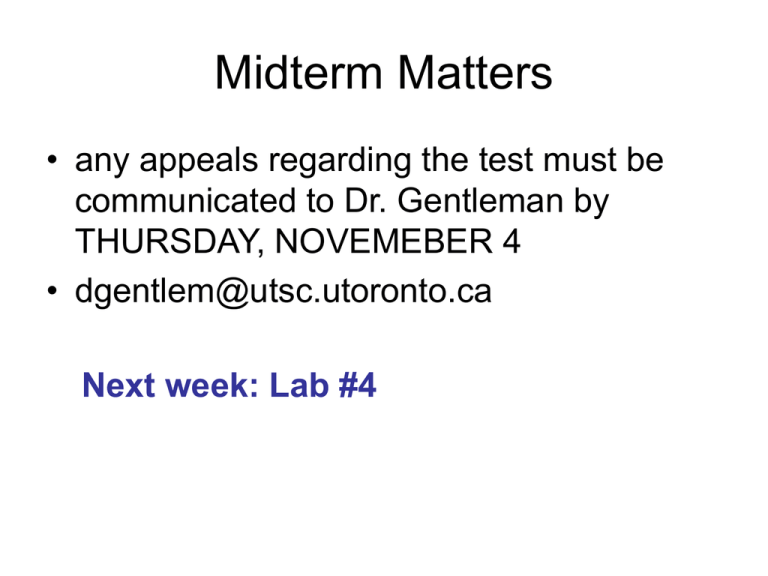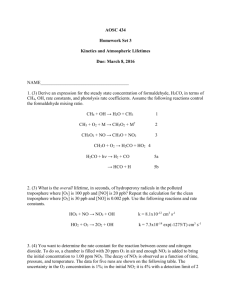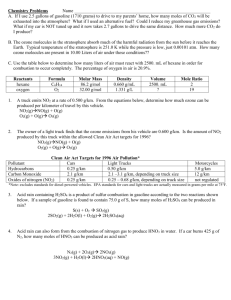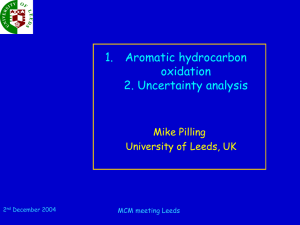lecture 3
advertisement

Midterm Matters • any appeals regarding the test must be communicated to Dr. Gentleman by THURSDAY, NOVEMEBER 4 • dgentlem@utsc.utoronto.ca Next week: Lab #4 What’s coming up??? • • Oct 25 Oct 27 The atmosphere, part 1 Midterm … No lecture Ch. 8 • Oct 29 The atmosphere, part 2 Ch. 8 • • • • • • • • • • • • • Light, blackbodies, Bohr Postulates of QM, p-in-a-box Hydrogen atom Multi-electron atoms Periodic properties Periodic properties Valence-bond; Lewis structures Hybrid orbitals; VSEPR VSEPR MO theory MO theory Putting it all together Review for exam Ch. 9 Ch. 9 Ch. 9 Ch.10 Ch. 10 Ch. 10 Ch. 11 Ch. 11, 12 Ch. 12 Ch. 12 Ch. 12 Nov 1 Nov 3 Nov 5,8 Nov 10,12 Nov 15 Nov 17 Nov 19 Nov 22 Nov 24 Nov 26 Nov 29 Dec 1 Dec 2 More about our atmosphere • Last time we discussed some aspects of stratospheric chemistry – This is mostly all about ozone • Today we will look at some chemistry which happens in the troposphere (below about 12 km altitude) Solar illumination on earth Pretty much all the energy which drives the earth comes as radiation from the sun Light absorbed by ozone in ozone layer • In the troposphere most chemistry starts with ozone and UV light … and often ends with CO2 – For example, oxidation of methane, whose balanced equation is: CH4 + 2 O2 CO2 + 2 H2O O3 + UV O* + O2 O* + H2O 2 OH OH + CH4 H2O + CH3 CH3 + O2 CH3OO CH3OO + NO NO2 + CH3O CH3O + O2 HCHO + HO2 HCHO + UV + 2O2 2HO2 + CO CO + OH + O2 CO2 + HO2 NO2 + UV NO + O O + O2 O3 HO2 + NO NO2 + OH Interesting note: the role of NO and NO2 in the troposphere is quite different from in the stratosphere. At lower altitudes, there is not the correct UV radiation (not enough energy, since it’s already been absorbed higher up!!)to form O atoms from O2 … tropospheric O (and so O3) is formed from NO2 Stratosphere Troposphere O2 + UV O + O O + O2 O 3 NO2 + UV NO + O O + O2 O 3 NO + O3 NO2 + O2 O + NO2 NO + O2 NO + O3 NO2 + O2 HO2 + NO NO2 + OH • So we see that NO reacts with radicals to make NO2, which reacts with sunlight and oxygen to make ozone • Ozone reacts with sunlight and water to make hydroxyl radicals (OH) • Hydroxyl radicals react with most substances to make oxidized products • These reactions all involve formation and destruction of free radicals… they are examples of chain reactions O3 + UV O* + O2 O* + H2O 2 OH OH + CH4 H2O + CH3 CH3 + O2 CH3OO CH3OO + NO NO2 + CH3O CH3O + O2 HCHO + HO2 HCHO + UV + 2O2 2HO2 + CO CO + OH + O2 CO2 + HO2 Radicals! The radical chains are broken by reactions which form products such as nitric acid and PAN: OH + NO2 HNO2 CH3COO + NO2 PAN • The NO comes from the reaction of N2 with O2 at high temperatures: – N2 + O2 2 NO DH0f(NO) = + 90.2 kJ/mol (what would le Chatalier say?) • Cars, trucks, buses, etc. • Power plants and factories • Lightning • Hydrocarbons (such as methane) come from transport, power plants, ruminant animals, rice paddies, trash dumps, … • Urban air pollution involves the same chemistry as we just saw, but more intense • The timing of photochemical smog generally tracks rush hours, and requires sunlight and warm enough (> 180 C) temperatures Emitted from cars Formed from NO + radicals Formed from NO2 + light Formed from NO2 + radicals We can help reduce such air pollution by using better engine designs and technology Urban films -grime on windows Particles -soot, PM2.5 H2 O Air pollution NOx O3 Organics H2O OH Chemistry affects all aspects of the lifetimes and fates of pollution compounds. For example, the uptake of water by organic particles to form haze on a polluted summer day: the oxidation state matters! moles H2O / mole of organic 5 Increasing O : C ratio 4 3 dodecane octanol octanoic acid 1,5-pentane-diol malonic acid 2 1 0 0 20 40 60 % Relative humidity 80 100 Oleic acid, and similar fatty acid compounds, are present in animal and plant cells. These compounds are observed in atmospheric particles due to ablation from leaves and from cooking Water uptake by oleic acid before and after oxidation by ozone CH3(CH2)7CH=CH(CH2)7COOH Moles water / mole oleic acid 4 After exposure 3 2 Before exposure 1 0 0 20 40 60 % Relative humidity 80 100 Amber Asad ( a UTSC student) measuring how water is sorbed by oleic acid And the result … Organic compounds + Oxidants (ozone, OH, …) + Water + Sunlight • We saw how organic carbon (ie- methane) is transformed to carbon dioxide in the atmosphere. Note that CO is formed, along the way. • Carbon monoxide is also a product of “incomplete combustion”, in much the same types of process as we saw earlier. • CO is problematic because it is a poison to oxygen-breathers like us. The way in which oxygen is transported in the blood is by binding to haemoglobin – a molecule in our red blood cells. It turns out that CO is better at binding to haemoglobin, so oxygen is blocked. • Sulfuric acid is another important atmospheric molecule: it is a primary source of acid rain (along with nitric acid, which we saw before) and, because it is very, very hygroscopic, it acts as a condensation site for water vapour • H2SO4 is formed in the atmosphere by the oxidation of sulfur-containing compounds (mostly from biological processes) to SO2, then to the acid • SO2 is a product of combustion and also is emitted by volcanoes • Once formed, SO2 reacts in the atmosphere: • SO2 + OH HSO3 • HSO3 + O2 HO2 + SO3 • SO3 + H2O H2SO4 • The sulfuric acid may be in the gas phase (where it will form water droplets) or dissolved already • Acid rain in this part of North America is mostly this acid Apart from air pollution, human introduction of hydrocarbons and their oxidation products into the atmosphere affects the carbon cycle These compounds, especially ones such as carbon dioxide, methane and halocarbons, can influence the heat balance in the troposphere by absorbing heat radiation (infrared light) emitted from the earth (“global warming”). The earth’s surface is warm enough to sustain life because of a greenhouse effect due to water vapour and some CO2. By increasing the concentrations of greenhouse gases, we are altering this effect Most of the observed warming in the past 50 years is attributable to human activities





